All of the material we consulted on Irish genealogy told us that looking for long-ago ancestors is hopeless because the records simply do 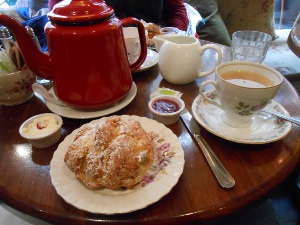 Afternoon tea
not exist. We wanted to see whether we could find some traces of our various Irish ancestors if we went to Ireland and hunted for the records locally. We soon found out they were correct: many times records of births, marriages or deaths had never been kept (especially, for the Roman Catholic Irish, in the years when the anti-Catholic penal laws were in effect); sometimes the records had been made but then destroyed by war or natural disaster; and recently many remaining historical records have been monopolized by local organizations who are require payment to view them.
Afternoon tea
not exist. We wanted to see whether we could find some traces of our various Irish ancestors if we went to Ireland and hunted for the records locally. We soon found out they were correct: many times records of births, marriages or deaths had never been kept (especially, for the Roman Catholic Irish, in the years when the anti-Catholic penal laws were in effect); sometimes the records had been made but then destroyed by war or natural disaster; and recently many remaining historical records have been monopolized by local organizations who are require payment to view them.
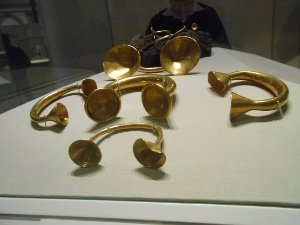 From Viking treasure
From Viking treasure
We arrived in Dublin in early May and gave our best tries, visiting archives, family history societies, the national library museums large and small, and signing up as members of genealogical societies, but soon learned that we would have little or no luck. In the process we learned much about Ireland's history, and some about its current affairs, and were introduced to one of the most stimulating cities, in one of the most beautiful countries we have yet visited.
This year, 2014, was Dublin's year as UNESCO City of Literature. While we were not aware of any particular events, we could not escape the presence of literary ghosts throughout the city. On our first walk from  James Joyce and friend
our hotel we found a statue of James Joyce looking raffish. We were to become used to statues of famous authors throughout the United Kingdom, but somehow they seem most at home in Dublin, perhaps because Joyce used such vivid descriptions of the people and places he knew as a young man.
James Joyce and friend
our hotel we found a statue of James Joyce looking raffish. We were to become used to statues of famous authors throughout the United Kingdom, but somehow they seem most at home in Dublin, perhaps because Joyce used such vivid descriptions of the people and places he knew as a young man.
Some days later we were planning to explore Dublin Castle, a large complex of buildings including military barracks and a parade square. The people waiting to enter were so numerous that we prepared to leave. But then we found a small museum in a corner: the Customs House Museum. It includes fascinating displays of Irish Customs officers' work through their long history. On one wall we found a poem written by Dennis O'Driscoll, a well-known Irish poet whose day job was as a clerk:
AT THE REVENUE MUSEUM
Sometimes at end of day,
they come to mind; old friends
and colleagues, bosses who were
sticklers for detail, dexterous drafters
of sub-sections, pluggers of loopholes,
custodians of the frosted public hatches,
income tax staff inured to tonguelashes,
larger-than-life characters - long dead
who live on in these museum rooms.
Officers whose squashed initials
left their marks on carbon-copy letters
in archived files, who ruled these
marbled papered daybooks now on show.
Staff who served in braided uniforms
like these at pre-single market prefab
border stations or made landside seizures
of contraband at airport exit channels.
And sometimes at end of day,
a silence probes so deep
it proves an audit of official lives,
the years from shyly signing
entry papers in the Personnel Branch
to the long-service presentation by the Board.
Years showcased here, impressed in wax,
crystallised in glass, enshrined in paper,
pewter, brass; the past saved for the future,
like a budget surplus, not excised from
the record but salvaged like scorched ledgers
from a war-torched Custom House.
We would find throughout our summer that poems and quotations and references would be found in many unexpected places. In Dublin alone we continued to come across literary objects. The National Library contains 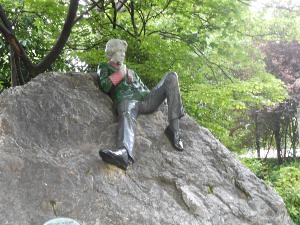 Wilde in Merrion Square Park
a Yeats exhibit, a beautiful set of rooms displaying his letters, poems and notes along with photos and explanatory captions. It was originally created as a temporary exhibit but received so many visitors and so much praise that it is now officially a permanent exhibit. Perhaps our favorite literary sighting in Dublin was the statue of Oscar Wilde in Merrion Square park.
Wilde in Merrion Square Park
a Yeats exhibit, a beautiful set of rooms displaying his letters, poems and notes along with photos and explanatory captions. It was originally created as a temporary exhibit but received so many visitors and so much praise that it is now officially a permanent exhibit. Perhaps our favorite literary sighting in Dublin was the statue of Oscar Wilde in Merrion Square park.
A must-see for all tourists is the Book of Kells, a treasure held by the Old Library of Trinity College. This beautiful illuminated manuscipt, dating from at least as early as the ninth century, was created in the islands off Scotland and moved several times to safety during the raids by the Vikings, ultimately landing in the library at Trinity College. We found the views of the Old Library at least as enthralling as the Book of Kells itself (partly because that exhibit is 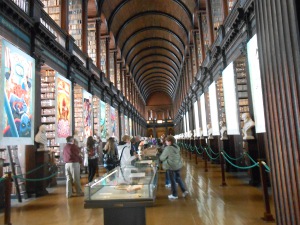 Old Library in Trinity College
always crowded). The library collection of ancient volumes is still used by scholars, requiring staff to climb the ladders to fetch the books.
Old Library in Trinity College
always crowded). The library collection of ancient volumes is still used by scholars, requiring staff to climb the ladders to fetch the books.
Dublin is filled with libraries. We visited quite a few of them, from the busy Public Library to the special Chester Beatty Library. This was the creation of one of the major bibliophiles of recent times, who devoted his life to collections in his several areas of interest. His staff organized and maintained his library, including restoring fragile volumes. In addition to exhibiting unusual art and texts, the library includes videos illustrating bookbinding and other crafts.
But history is presented in many places beyond libraries. Take, for example, the National Museum of Ireland. Ireland is a natural for 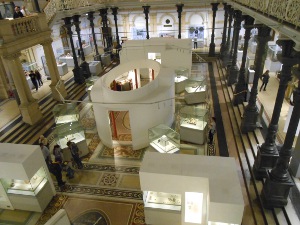 Archaeological treasures
archaeology. Peat bogs preserve things (including mummified people), there was a great habit of burying things in the ground so they wouldn't be stolen (lots of raiders about) and then perhaps the one who buried them dies before he or she has time and opportunity to dig them up. The Irish were seafaring and so they were also pirates and shipwreck salvagers. Ireland has not been the scene of any of the violently destructive twentieth century wars, so treasure hoards are preserved.
Archaeological treasures
archaeology. Peat bogs preserve things (including mummified people), there was a great habit of burying things in the ground so they wouldn't be stolen (lots of raiders about) and then perhaps the one who buried them dies before he or she has time and opportunity to dig them up. The Irish were seafaring and so they were also pirates and shipwreck salvagers. Ireland has not been the scene of any of the violently destructive twentieth century wars, so treasure hoards are preserved.
Let us not forget bookstores. In a scruffy little shop next to our laundry, a booklover tends his stock of used books, some of which are almost new. During our month in Dublin we acquired several excellent novels including mysteries unknown to American readers. Of course all museums have bookstores including well-selected books among their gifts and souvenirs. One bookstore not far from Trinity College dates back to the days when James Joyce was a regular customer.
 Afternoon tea
not exist. We wanted to see whether we could find some traces of our various Irish ancestors if we went to Ireland and hunted for the records locally. We soon found out they were correct: many times records of births, marriages or deaths had never been kept (especially, for the Roman Catholic Irish, in the years when the anti-Catholic penal laws were in effect); sometimes the records had been made but then destroyed by war or natural disaster; and recently many remaining historical records have been monopolized by local organizations who are require payment to view them.
Afternoon tea
not exist. We wanted to see whether we could find some traces of our various Irish ancestors if we went to Ireland and hunted for the records locally. We soon found out they were correct: many times records of births, marriages or deaths had never been kept (especially, for the Roman Catholic Irish, in the years when the anti-Catholic penal laws were in effect); sometimes the records had been made but then destroyed by war or natural disaster; and recently many remaining historical records have been monopolized by local organizations who are require payment to view them.
 From Viking treasure
From Viking treasure
 James Joyce and friend
James Joyce and friend Wilde in Merrion Square Park
Wilde in Merrion Square Park Old Library in Trinity College
Old Library in Trinity College Archaeological treasures
Archaeological treasures